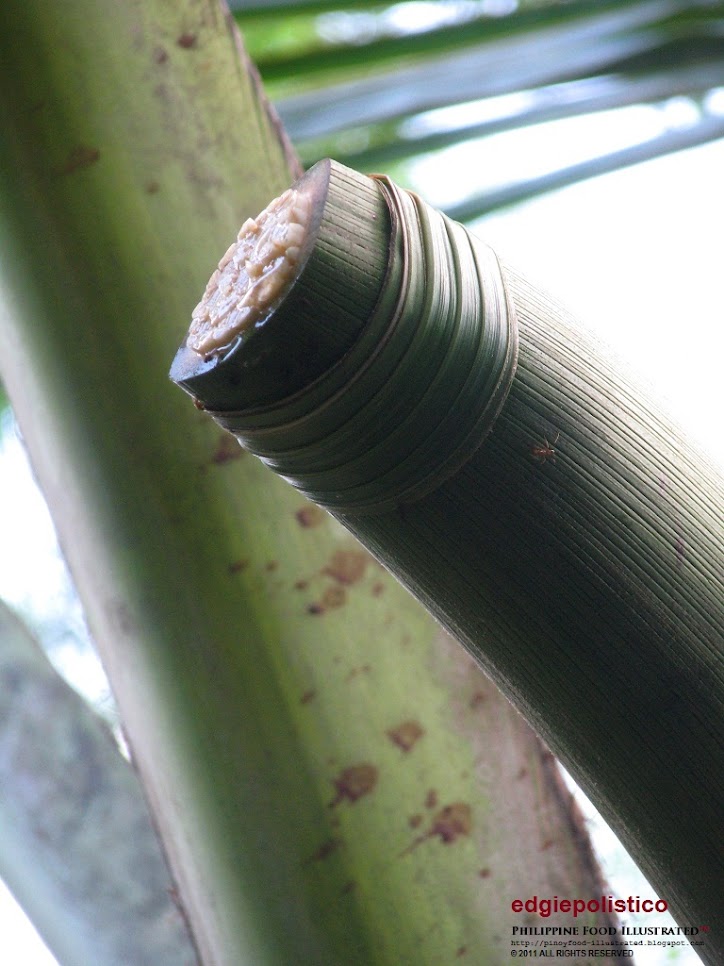.jpg)
sweet tuba - /swet tu-bâ/ (Pangasinese sap/drink) [n.] fresh toddy of raffia palm.
tuba or tuba ng buri in Tagalog and Batangueño
a.k.a. tuba silag in Pangasinense
It is the sweet freshly gathered toddy of buri palm (raffia). When freshly gathered in the morning, it can be taken as a naturally sweet refreshing drink.
Sweet tuba needs to be chilled in ice or stored in freezer to extend shelf life for few more hours, or to last for at least late in the afternoon. Otherwise, it would start to sour by high noon, and by early evening the toddy would become a slighltly sour vinegar. However, despite employing the chilling technique, the toddy still would start to sour by evening. Freezimg would only delay souring a little more.
While still fresh and sweet, the Pangasinenses would boil the sweet tuba till thick and sticky, as in the way they used it as their sticky sweetener in making the Pangasinense patupat (glutinous rice in square-woven strips of coconut palm).
In Batangas, it is made into Batangueño pakaskas (raffia sap jiggery, which is now replaced with juice extracted from sugarcane), or processed into bagkat (raffia sap taffy). Sweet tuba will not last long in a day. By afternoon, or past noon, the toddy would start to sour that by evening it becomes a lightly soured vinegar.
In a few more days, it will be a full-pledged vinegar known in Ilocano as sukang buli (raffia palm vinegar) or tuka silag in Pangasinense.
.jpg) |
| A serving of sweet tuba in a glass filled with cracked ice. |
.jpg) |
Sweet tuba sold in glass bottle (using recycled soda bottles) in Balungao, Pangasinan.
All photos by Edgie Polistico are copyrighted. ALL RIGHTS RESERVED.
If you liked this post and our site, share it.
Let us know your opinion on the subject. Feel free to comment in the comment section, below. It is important for us to know what you think.
Tell us what other topics you would like us to write, share, and discuss about.
Continue to follow my blogs. You can also follow and learn more by joining us in our Facebook group. Have more bits and pieces about our kind of food, ingredients, and ways of cooking, dining, and knowing food culture across the 7,641 islands of the Philippines.
Encouragement and enthusiasm are not enough. I also need moral support, prayers, and anything else that can uplift my spirit and keep my good reasons. Keep them coming. All I know is that I am happy with what I am sharing and giving away. If you are pleased and happy with what I am doing, just smile and please share the happiness. Keep sharing and include to share the PHILIPPINE FOOD ILLUSTRATED. I feel energized when my blog becomes one of the reasons why you are happy and smiling.
Edgie Polistico |






.JPG)
.JPG)
.JPG)



.JPG&container=blogger&gadget=a&rewriteMime=image%2F*)
.JPG&container=blogger&gadget=a&rewriteMime=image%2F*)
.JPG&container=blogger&gadget=a&rewriteMime=image%2F*)
.JPG)


.jpg)
.jpg)
.jpg)
.jpg)
.jpg)
.jpg)
.jpg)

%20by%20Edgie%20Polistico.png)
.JPG)
.JPG)

















